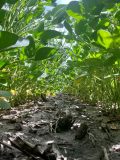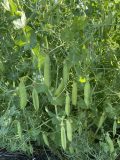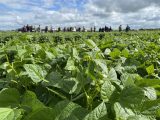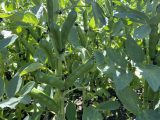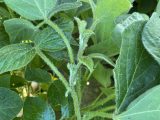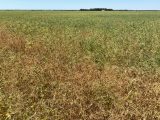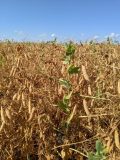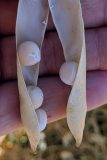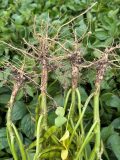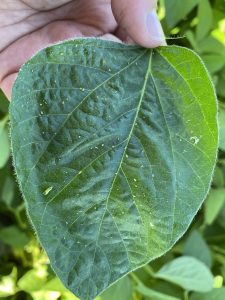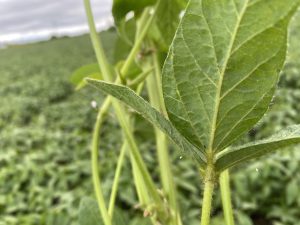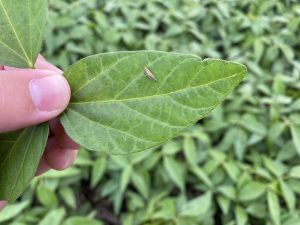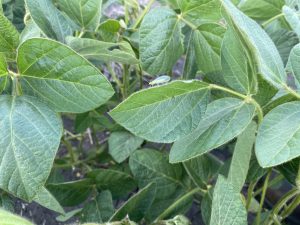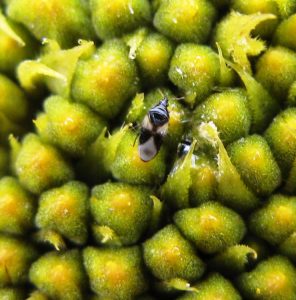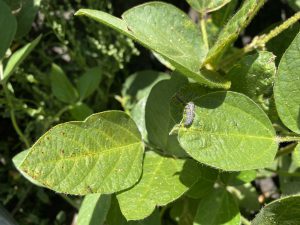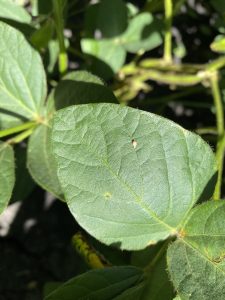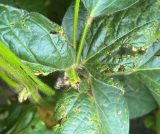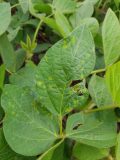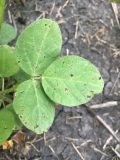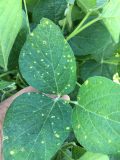 AUGUST 17, 2022
AUGUST 17, 2022
- Crop and Scouting Update
- Soybean Aphids and Natural Enemies
- Field Pea Desiccation Timing
- Excessive Weed Pressure: Preharvest Weed Control
- Keep it Clean’s 2022 Product Advisory
- 2022 Soybean Disease Survey
Listen to the Bean Report:
Crop and Scouting Update
- Soybeans are filling pods and are at the R4 (pods 3/4″ long at the top four nodes) to R6 (full seed) stages.
- Soybean aphids are present in several regions, in some areas occurring at high numbers close to spraying thresholds. Heavy rains on Monday should have knocked back aphid populations in some regions. Continue to scout until R6 when seeds are firm.
- Grasshoppers are continuing to be a challenge in some fields and need to be monitored.
- Field peas range from full pod (R4) to full maturity (R7) stages.
- Once seeds fill the capacity of pea pods (R4 – full pod), fungicide applications are no long recommended since most crops will be within the 30-day preharvest interval of fungicide products. Once pods are full, pea aphid control is likely no longer necessary.
- Dry beans range from R6 (50% seed) to R8 (beginning maturity) stages.
- Monitor grasshopper defoliation levels and if any pod feeding is evident. Watch for lygus bugs in light-coloured beans and potato leaf hoppers.
- Faba beans are at R5 (full pod) where seeds fill the pod cavity.
- Lygus bugs have been confirmed in some faba bean fields, their sucking mouth parts pierce pods and seeds and will make pin holes in the seed coat. Lygus do not affect yield but seed quality is affected and can cause downgrading. Check out the scouting session video here.
Soybean Aphids
Soybean aphid populations have been increasing in some areas. We are still a ways away from R6 (full seed) stages where yield loss is expected to be minimal and soybeans are considered ‘safe’ from aphids. Keep in mind these scouting tips:
- Scout weekly from R1 (beginning bloom) to R5 (beginning pod) stages.
- Accurate assessments require two field visits 3-5 days apart to see if the aphid population is increasing or decreasing.
- If the population is the same or decreasing, natural enemies and environmental conditions (like heavy rains) may be managing the aphid population.
- Count or estimate the number of soybean aphids per plant on at least 30 plants in the field (6 plants in 5 areas).
- Estimate Method #1: Count the number of aphids on one leaf or stem section and multiply by the number of leaves or stem sections with similar amounts of aphids.
- Estimate Method #2: Use the Speed Scouting for Soybean Aphid worksheet where plants are marked as ‘infested’ if more than 40 aphids are present and ‘non-infested’ if less are present per plant. This method may over-recommend treatments, so at least two field visits is recommended to verify management decisions.

Source: University of Minnesota Extension
- The action threshold for soybean aphids is 250 aphids per plant on average and increasing. This action threshold allows a 7-day lead time for control before populations with few natural enemies preset are expected to reach the economic injury level of 674 aphids per plant.
- If control is necessary, assess product efficacy following application to ensure aphids have been controlled. Pyrethroid-resistant soybean aphids were verified in Manitoba in 2017 and have been reported in the states where our aphid populations blow in from.
Natural Enemies of Soybean Aphids
Insect predators, parasitoids and fungal pathogens are natural enemies of soybean aphids and can significantly reduce populations. Key natural enemies to scout for include:
- Lady beetle larvae – little black alligators, seven-spotted lady beetles can consume up to 118 aphids/day, multi-coloured Asian lady beetles can consume up to 107 aphids/day.
- Hover fly (Syrphid) larvae – can consume up to 17 aphids/day, also feed on thrips and other insects, adult form is an important pollinator.
- Green lacewing larvae – little brown lions, can consume up to 36 aphids/day, also consume insect eggs, caterpillars and other insects, they inject a digestive secretion into prey.
- Aphidoletes midge larvae – predators of >60 species of aphids, they suck out the body contents of aphids, leaving a blackened shell attached to the leaf.
- Minute pirate bug – can consume up to 11 aphids/day.
- Parasitoid wasps – spend their lives attached to or within their aphid host and eventually kill it, the Aphelinus species causes black aphid mummies, the Lysiphlebus species causes brown mummies.
For information on soybean aphids, check out MPSG’s Soybean Aphids: Identification, Scouting and Management fact sheet.
Field Pea Desiccation Timing
- Peas are ready for desiccation, preharvest weed control or swathing when at least 80% of the field is at R7 (full maturity). This is when 80% of pods are ripe, golden-brown and seed moisture is less than 30% in the least mature parts of the field.
- To determine if peas are ready for desiccation, scout the least mature areas of the field and check pods. Seeds in the bottom pods should rattle, seeds in the middle pods have changed colour and seeds in the upper pods will have some colour change and split evenly under pressure rather than squash. Consult the Field Pea Desiccation and Harvest Guide for photos for more information on timing desiccation applications.
- Consult with your buyer on the products they accept and ensure you’re following the preharvest interval. If it’s too late to desiccate, there is the option to swath and leave them for a day or two to dry down (ensuring the winds will be minimal), then combine very soon after. Beware that pea swaths are highly prone to blowing.

Excessive Weed Pressure: Preharvest Weed Control
The Importance of Using Glyphosate Carefully:
- Markets around the world are testing more frequently for chemical residues. Testing is more readily available, cheaper and easier to do than in the past. As a result, there is more scrutiny in the global marketplace.
- Maximum residue levels (MRLs) for glyphosate in pulse crops vary throughout the world and are lower in several Canadian export markets than in Canada. This presents a risk to Canadian farmers. Some markets have no tolerance for glyphosate altogether, due to consumer demand.
- This means it is more important than ever to use glyphosate correctly, following label directions and using it for preharvest weed control, not as a desiccant. Staging for applications is critical – applying once the crop is below 30% seed moisture, which is described above.
Are you considering or did you use glyphosate as a preharvest tool this year?
Pulse Canada has developed a Farmer Quality Testing Program to provide free, confidential residue testing for farmers and agronomists to ensure the proper application timing of preharvest glyphosate for pulse crops. The results of the program will allow farmers to further ensure the effective application of pre-harvest glyphosate and maintain the world-class quality of Canadian pulses. Peas, lentils, chickpeas and faba beans qualify. Interested in this opportunity? Check it out here.
Keep it Clean’s 2022 Product Advisory
2022 Soybean Disease Survey
Each year, MPSG agronomists participate in the soybean disease survey led by Agriculture and Agri-Food Canada and Manitoba Agriculture. This survey normally takes place from late July to early August at the R4-R5 stages however this year with later seeding dates these stages lined up mid to late August.
What does this survey provide?
- Root rot results from roots samples that are collected by surveyors and tested in-lab at AAFC.
- Severity ratings of foliar diseases, including bacterial blight, Septoria brown spot and downy mildew, along with information on how many fields across the province have the disease (prevalence) and how many plants are infected within fields (incidence).
- Prevalence and incidence of stem diseases, like northern stem canker, white mould, Phytophthora root and stem rot and others.
- A watchful eye for the less common diseases (e.g., soybean cyst nematode) or those that have not yet been detected in Manitoba (e.g., brown stem rot).
Preliminary 2022 results
- Bacterial blight and Septoria brown spot have been common in fields surveyed thus far, but occur at low severity levels that are not expected to influence yield.
- Downy mildew and frogeye leaf spot have been detected in some fields at trace amounts (meaning the odd leaf is infected with these diseases).
- Small amounts of phytophthora root rot and northern stem canker have been detected, mainly present in fields with previously high disease pressure.
Where to find the detailed, regional results?
Each year, the results are summarized in MPSG’s Pulse Beat magazine and made available at manitobapulse.ca. See the 2021 results here.
On-Farm Network Update
Harvest and Results are Just Around the Corner
The field season is quietly winding down, revealing a moment to catch your breath before harvest arrives in full force. Though it’s hard to believe that August is over halfway gone, the On-Farm Network (OFN) is eagerly anticipating harvest to collect and analyze the last of the data from the 2022 field trials. It can’t go without saying that the OFN team was grateful for the Agronomy Assistants this season, Mikayla Melnick and Chloe Hodgson, who spent much of their time driving across the province collecting data throughout the summer. As crops mature, keep resources such as the Soybean Maturity Guide or the Field Pea Desiccation and Harvest Guide in mind to help guide your decisions through the final stretch of the season. The OFN would like to wish everyone a safe and successful harvest!


